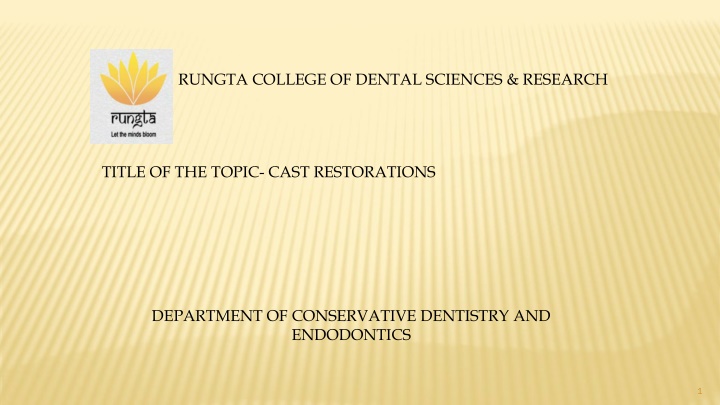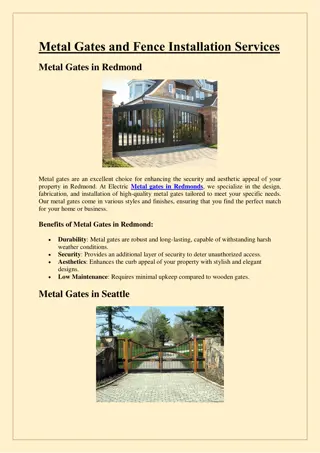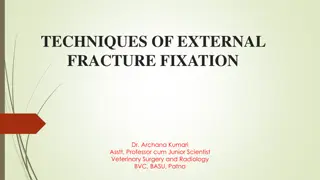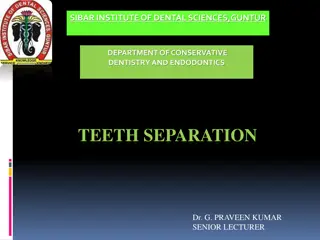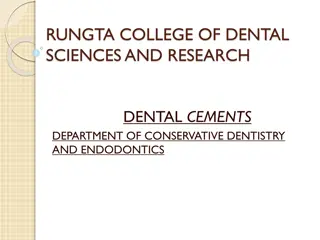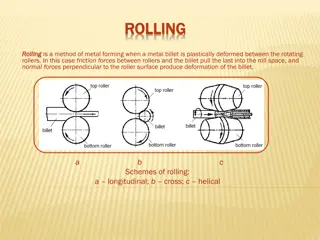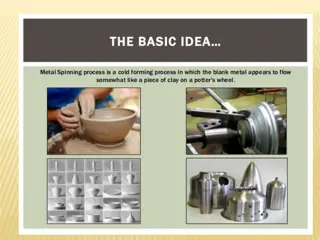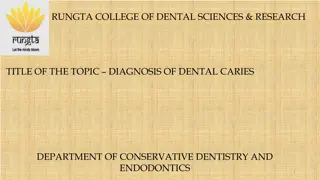Metal Cast Restorations in Conservative Dentistry & Endodontics
This presentation focuses on metal cast restorations, covering topics such as indications and contraindications, principles of tooth preparation, steps involved, modifications, additional retention methods, casting defects, primary and secondary retention forms, luting cements, grooves, and more. The content provides in-depth knowledge essential for learners in the field of Conservative Dentistry and Endodontics.
Download Presentation

Please find below an Image/Link to download the presentation.
The content on the website is provided AS IS for your information and personal use only. It may not be sold, licensed, or shared on other websites without obtaining consent from the author.If you encounter any issues during the download, it is possible that the publisher has removed the file from their server.
You are allowed to download the files provided on this website for personal or commercial use, subject to the condition that they are used lawfully. All files are the property of their respective owners.
The content on the website is provided AS IS for your information and personal use only. It may not be sold, licensed, or shared on other websites without obtaining consent from the author.
E N D
Presentation Transcript
RUNGTA COLLEGE OF DENTAL SCIENCES & RESEARCH TITLE OF THE TOPIC- CAST RESTORATIONS DEPARTMENT OF CONSERVATIVE DENTISTRY AND ENDODONTICS 1
SPECIFIC LEARNING OBJECTIVES At the end of this presentation the learner is expected to know ; Core areas* Core areas* Domain Domain ** ** Category # Category # Introduction Definition Techniques Cognitive Cognitive Psychomotor Nice to know Must know Must know *Subtopic of importance ** Cognitive, Psychomotor or Affective # Must know , Nice to know & Desire to know ( Table to be prepared as per the above format ) 2
CONTENT Indications of Metal Inlay and Onlay Contraindications of Metal Inlay and Onlay Principles of Tooth Preparation for Cast Metal Inlay Steps of Tooth Preparation for Inlay Modifications in Class II Tooth Preparation for Inlay Tooth Preparation for Cast Metal Onlay Additional Retention and Resistance Form Features for Cast Restoration Technique for Making Cast Metal Restoration Casting Defects Pin Retained Cast Restorations
Retention Features Principal/Primary Retention forms: Parallelism Dovetails Surface area frictional retention Masticatory loads directed to seat the restoration
Secondary/Auxiliary Retention forms Luting Cements: Their action is primarily mechanical, locking the cast to tooth structure by filling the space between them, wetting the details of both the casting and tooth preparation and filling in these vacancies or irregularities Luting cements used: Type I GIC, Zinc Polycarboxylate
GROOVES: Located completely in dentin Can be located at the mesial & distal wall the gingival floor of the facial or lingual portion of a cavity preparation Should be located as internally as possible, adjacent to the axial wall Prevent lateral displacement of the mesial, distal, facial & lingual parts of restoration
Can also be located externally in extra coronal preparation, they can be placed anywhere where there is sufficient dentin bulk without impinging on the pulp chamber, root canal system or other anatomy
Reverse Bevel Placed at expense of the gingival floor, creating an internal dentinal plane including gingivally-axially, locking the restoration & preventing proximal displacement
Internal box Most efficient immobilizing retention, resistance means Prepared in dentin with four vertical surrounding walls joining a floor at definite line & point angles Can be located next to marginal ridge with intact proximal wall Should have a minimum size of 2mm in three dimensions, but should not have equal length, width & depth
External box A preparation opening to the axial tooth surface with three, four or five surrounding walls & floors They can be proximal, facial or lingual
Slot is a internal cavity within a floor of preparation having a continuous surrounding walls & floors Junction between the floor & surrounding walls is rounded Less locking than an internal box Slot should have a 2 to 3 mm depth
Pins Can be cemented & threaded, parallel & non parallel, vertical & horizontal, cast & wrought Collar Is a surface extension completely surrounding a cusp or a surface of a tooth Skirt Is a specific extension involving a part of the axial angle of a tooth
Finish Line Configurations (Margins) Finish line refers to the border of the preparation where the prepared tooth structure meets the unprepared surface of the tooth A smooth, well defined finish line is beneficial, regardless of the design used, to facilitate the laboratory procedures and finishing of the restoration
Various Margins A Knife Edge B Chamfer C Shoulder D Bevelled Chamfer E Bevelled Shoulder
Preliminary Shaping: Tapered fissure burs or diamond stones with or without rounded ends Cutting strokes should be pre-planned Rotary tools should be carefully selected and dimensions measured Gross Removal of Tooth Structure: Cylindrical diamonds (#555) or Tapered Carbides (No.271) Proximal Reduction: 169L or 699 Carbide burs used in bucco-lingual direction Instrumentation for Tooth Preparation
Removal of undermined enamel & gaining access: Removed with hand cutting inst like Enamel hatchets, Chisels These are self limiting in cutting undermined enamel only Rotary burs are seldom used Removal of Carious Dentin & Placing of Bases: Spoon Shaped Excavators Round burs (No.2 & 4) Boxing Up: Tapered fissure bur
Formulation of Cap and Shoe Anatomy: Cylindrical diamond stones or tapered fissure burs Bevels and counter-bevels given with Round carbides or ball shaped diamond stones Merging Walls & Bevels: Round or Hour Glass Shaped Diamond Final Shaping: Mainly done with Hand Instrumentation Chisels, Hatchets, GMT s, Angle formers Finishing burs
Designs of Cavity & Tooth Preparation The general designs of tooth preparation to accommodate cast restorations: Inlays Onlays
An Inlay is an intra-coronal cast restoration which involves the occlusal and proximal surfaces of a posterior tooth
Tooth Preparation for Inlays Indications: Cavity width not to exceed 1/3 of inter-cuspal distance Strong, self-resistant cusps Indicated teeth have minimum or no occlusal facets Tooth is not to be used as an abutment in FPD or RPD Occlusion or occluding surfaces are not to be changed by the restorative procedure
TAKE HOME MESSEGE/ FOR THE TOPIC COVERED (SUMMARY) Cast metals are used as copings or substructures for metal- ceramic restorations, one of the most common types of esthetic crown and bridge prostheses, and the most durable of esthetic restorations, especially when used to restore posterior teeth. The principles of molten metal solidification and equilibrium phase formation during the casting of metals are presented in this chapter. The key terms above will facilitate an understanding of the phase transformations and structures formed in cast dental alloys. 21
QUESTION & ANSWER SESSION 1. Write in brief about occlusal and gingival bevels. 2. Write a short note on secondary retention forms. 3. Short note on types of margins. 4. Write in brief about general principles of tooth preparation for cast restorations. 22
REFERENCES Sturdevant s Art & Science of Operative Dentistry Operative Dentistry M.A. Marzouk Fundamentals of Operative Dentistry J.B. Summit Fundamentals of Tooth Preparation H.T. Schillinburg Bonded Ceramic Inlays J.F. Roulet & S. Herder Fundamentals of Fixed Prosthodontics H.T. Schillinburg Handbook of Inlays, Crowns & Bridges G.F. Kantorowicz Dental clinics of North America GPT - 8 Internet Sources( google)
THANK YOU 24
